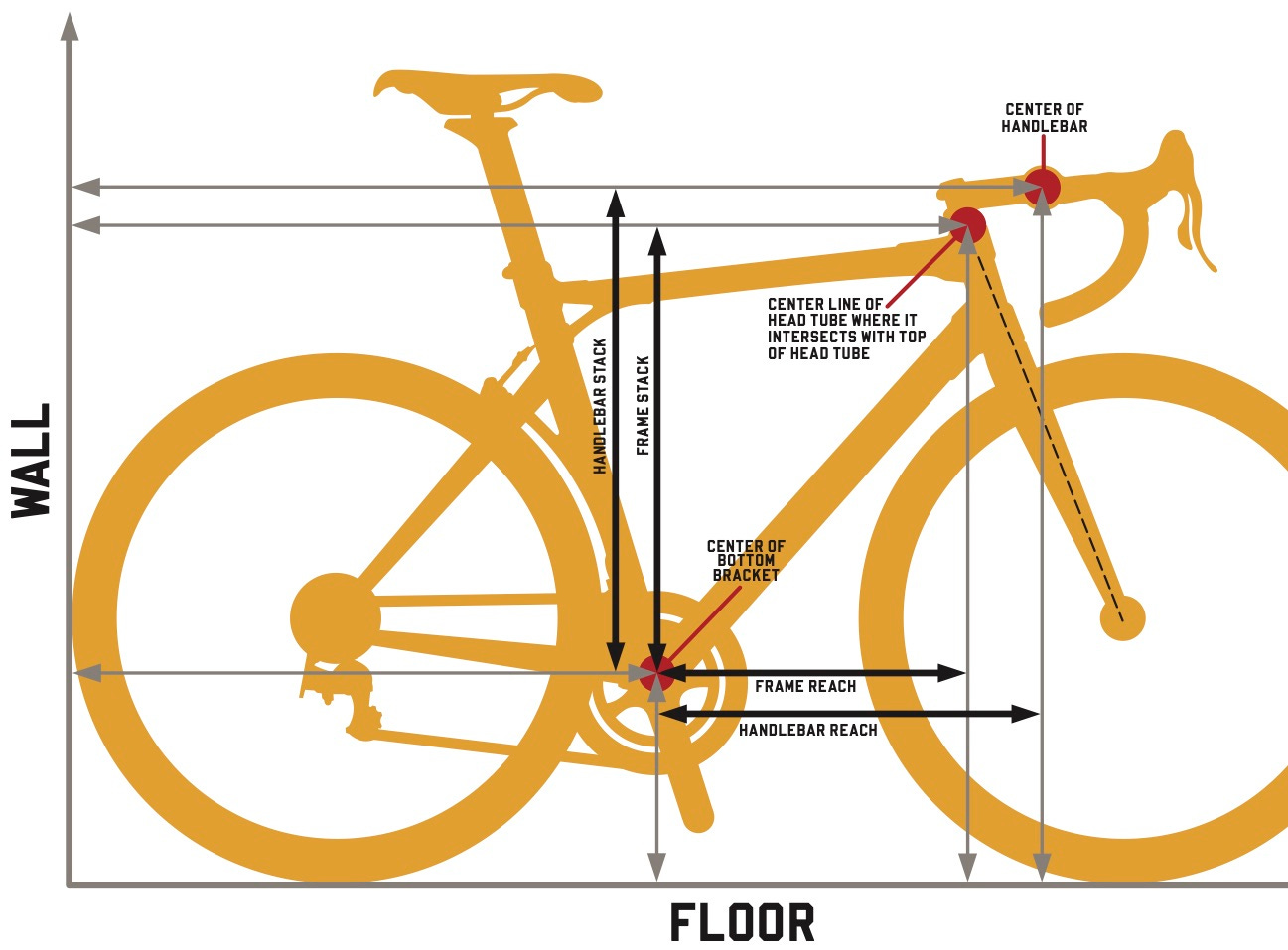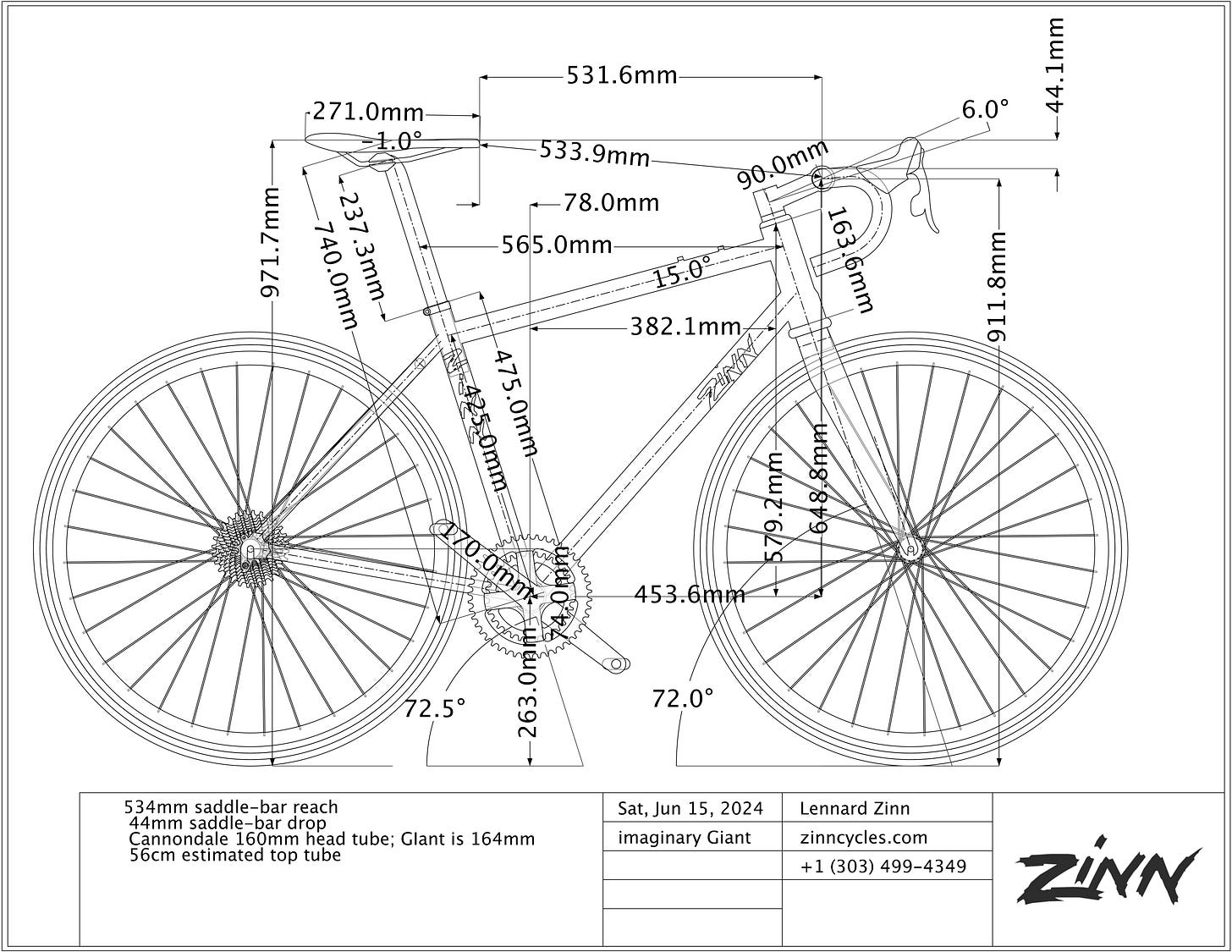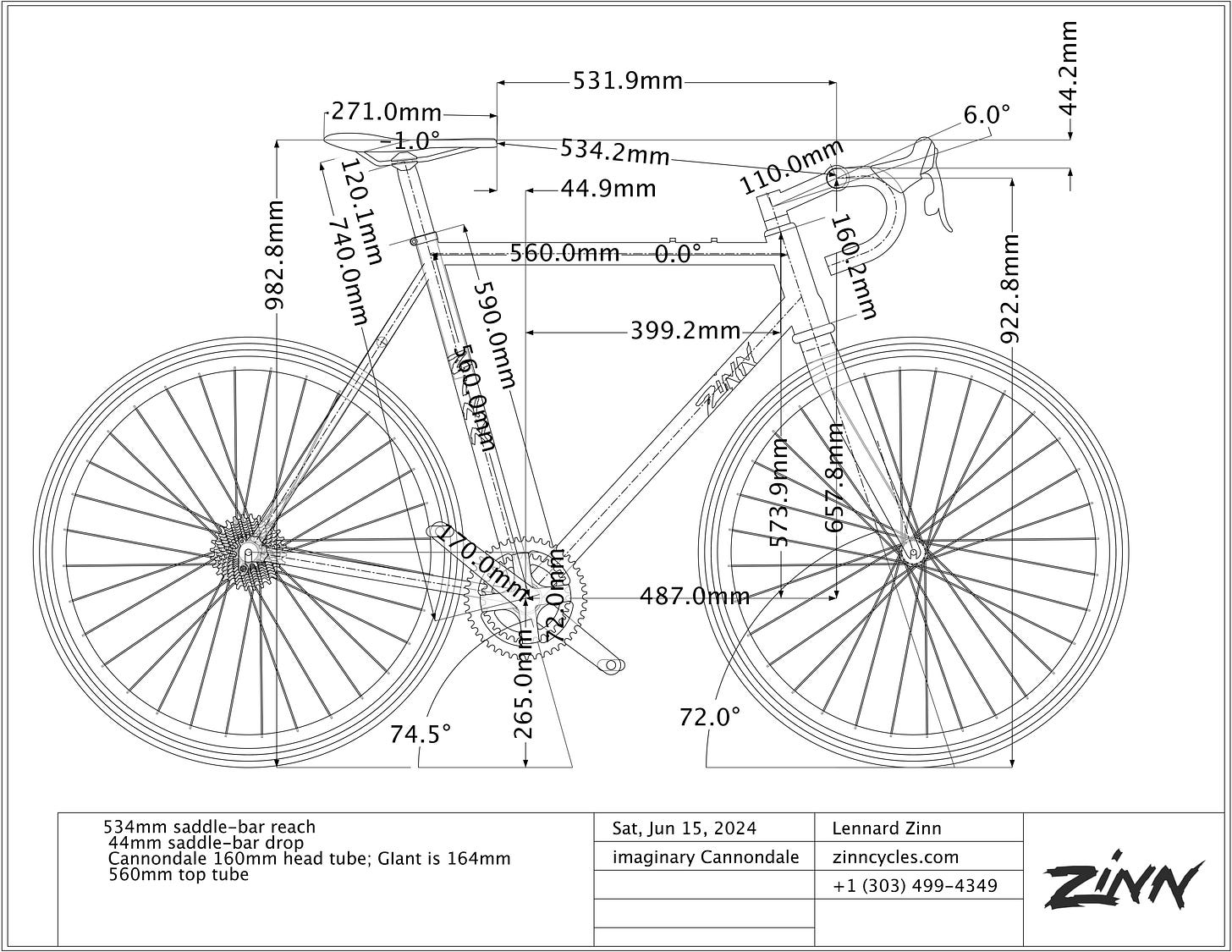Using Stack and Reach to Address Bike Fit Issues
How an X-Y coordinate system can eliminate apples-to-oranges comparisons when replicating bike fit.
Dear Lennard,
I have two old road bikes. My aluminum Cannondale has a level top tube and dates from the 1980s. My aluminum Giant TCR has a sloping top tube and is from around 1990. No matter how I try to make the setup on both bikes the same, they always feel different when riding them.
I have made the seat height the same and the distance from the front of the seat to the handlebar the same, too. To as close as I can measure it, the saddle is 1-3/4” higher than the handlebar on both bikes. They both have Turbo saddles and 170mm cranks.
I can measure the top tube length on the Cannondale by going from the center of the seat tube to the center of head tube along the top tube. If I estimate level on the tape measure with the Giant and try and hold the end of tape at what looks like the center of the head tube near the weld and go to what looks like the centerline of the seatpost, it seems to measure about the same as the Cannondale and about what I thought it was: 56cm. Because of the sloping top tube on the Giant, if I measure its top tube along the tube itself, it is quite a bit shorter than the Cannondale’s. The compact geometry also means its seat tube is way shorter.
Head tube lengths are almost the same (the Giant’s head tube is 4mm longer). The stem length is shorter on the Giant (maybe 1.5 or 2cm—it’s a bit hard to tell), but, again, the distance to the saddle is the same as on the Cannondale.
The Giant is more comfortable to ride, especially on bumpy roads, and I usually go a little faster on the same climbs on it (they are almost the same weight). But if I’m trying to go fast on the flats or am pushing into a headwind, I’m less comfortable riding in the drops on the Giant than on the Cannondale, even though they have the same width handlebars. I don’t have dimensions for either bike, but, again, I’ve tried to make them the same. Do you have any idea what’s going on here? How can I get them to fit more the same?
Frank
Dear Frank,
I love this question! Yes, I think I do know what’s going on. Even if you had the geometry tables from those bikes (which would have only been available printed on paper—hard to imagine now!), they would be missing the critical dimensions that would clarify this, namely “Stack” and “Reach.” I can best explain with some drawings.
Stack and Reach are the Y and X coordinates, respectively, of any point on the bike in an X-Y coordinate system whose origin is at the center of the bottom bracket. In the context of your fit on these bikes, the critical dimensions are the stack and reach of the top of the head tube at its centerline (called “frame stack and reach”), the stack and reach of the center of the handlebar inside of the stem clamp (called “bar stack and reach”), the seat height, and the seat setback (the “reach” dimension of the tip of the saddle nose).
I have made two drawings to explain this—one of an imaginary Cannondale and one of an imaginary Giant TCR roughly adhering to my interpretation of your descriptions of your bikes. I don’t know the actual dimensions of those bikes, and, while it might be possible to Google them, their exact dimensions are not germane to getting the point across. And the drawing at the top of this post shows you how to measure these critical dimensions yourself. Then you can put in the corrections that would make your fit on these two bikes feel the same.
I started with a 2cm shorter stem on the imaginary Giant and worked back from there.
I chose to set the seat angle of the imaginary Giant at 72.5 degrees and that of the imaginary Cannondale at 74.5 degrees to get the top tubes roughly the same 56cm as you measured. I made the top tube of the Cannondale right at 560mm (56cm).
Since it would be tough for you to find the centerline continuation of the Giant’s seat tube on the flat aero seatpost they came with as well as estimating where the center of the head tube is, I randomly made the Giant’s effective horizontal top tube slightly different: 5mm longer—565mm (56.5cm). One variation I made to get your ~4mm difference in head tube length was to make the imaginary Giant’s bottom bracket 2mm lower than that of the imaginary Cannondale.
As you can see, I made the seat height from center of bottom bracket to top center of saddle the same, at 740mm, the crank length at 170mm on both bikes, and the saddle shape and angle the same. The distance from saddle nose to bar is also the same, namely 534mm. I also made the drop from the top of the saddle nose to the top of the handlebar the same as you said you measured, namely 1-3/4” (44mm). I don’t know the actual measurements of your bikes, these are intended to be analogous to yours, not identical to yours.
Even though those fit dimensions are the same in the same ways you made yours, critically, all the stack and reach dimensions on the two bikes are different, and that would explain the difference in feeling you have between them. Due to the imaginary Giant’s shallower seat angle, its saddle setback (the X coordinate, or reach dimension, of the tip of the saddle’s nose) is 33mm greater (78mm vs. 45mm setback for the imaginary Cannondale). Similarly, the imaginary Giant’s frame reach and bar reach dimensions are less than those of the imaginary Cannondale (382mm vs. 399mm and 454mm vs. 487mm, respectively).
And despite the only ~4mm difference in head tube length you mentioned (here, 164mm vs. 160mm), the frame stack dimensions (579mm for Giant vs. 574mm for Cannondale) differ by more than that. Finally, despite the identical drop from saddle to bar, the bar stack dimensions differ by 11mm, with the Giant being less (649mm) than the Cannondale (638mm).
How can these differences in stack and reach explain your differing perceptions when riding these two bikes?
Well, the greater setback of the saddle relative to your feet means that your hip angle will be folded more tightly on the Giant than on the Cannondale, despite the drop from saddle to bar being the same. That means your low back and hamstring muscles will be tighter when riding the Giant, and your knees will come up closer to your belly and chest, possibly restricting breathing a bit more than on the Cannondale. This could easily explain why you feel less comfortable riding in the drops on your Giant. Your faster climbing speed on the Giant might indicate that you prefer pushing from behind the pedals when at high power output and low cadence more than you do from straight above them.
What can you do to make your two bikes fit the same?
You would make the stack and reach coordinates of the saddle and bar be the same on both bikes.
While electronic tools exist for finding stack and reach (with the process even dubbed “zinning” on Retül), as do manual X-Y bike-fit tools consisting of a pair of long, sliding rulers at 90 degrees to each other with a pin to locate the crank center, you can get similar accuracy with a tape measure using the following method.
As in the illustration at the top of this post on which stack and reach of the frame and handlebar are indicated, stand the first bike up vertically, rear tire touching a wall, front wheel in line. Without an assistant, securing it is a challenge. If parallel to a cabinet, try strapping the handlebar to a drawer. Alternatively, with the bike crosswise across a garage entrance, overhead door open, strap the rear wheel into the channel of the garage door’s roller track, and strap the front wheel to the down tube so it lines up with the bike.
Measure from the center of the crank horizontally back to the wall (or garage door roller track) that the rear tire is touching. Subtract this horizontal measurement from the horizontal distance from the same wall (or track) to any other point on the bike; this will be that point’s X-coordinate (its “reach”). Use this method to find the reach to the center of the handlebar and the reach to the center of the saddle or to the nose or tail of the saddle or to your sitbone-contact point on the saddle.
Similarly, measure the height of the crank center from the floor. Subtract this bottom bracket height from the vertical height off the floor of any other point on the bike; this will be that point’s Y-coordinate (its “stack”). Use this method to find the stack to the center of the handlebar and the stack to the top center of the saddle or to your sitbone-contact point on the saddle. You can also measure the stack to the nose or tail of the saddle, as long as the two saddles are identical and that you ensure that the saddle tilt (the angle of the saddle relative to horizontal) is identical on both bikes.
To replicate the fit on the second bike, stand the second bike up the same way with its rear tire against the wall or track and measure from the floor vertically and from the wall or track horizontally to its crank center, saddle top center point (or sitbone-contact point on the saddle), and handlebar center. Since you have the same saddle model on both bikes, you can also measure horizontally to the nose or tail of the saddle, since those are more definitive points and easier to measure to get both bikes the same. Subtract off the horizontal and vertical measurements to the crank center to find the stack and reach of the points on the saddle and handlebar. Adjust the bar and saddle positions until their stack and reach measurements (and saddle tilt) match those of the first bike; in your case, it will require changing stem length on at least one of your bikes.
Any Retül fitting center, found in many bike shops, can measure your bike’s stack and reach with a handheld digital mapping wand. Electronically “zinning” the bike (no kidding; it’s a verb in Retül parlance!) means running said wand over the saddle, bar, and grips or brake hoods to identify the stack and reach of those latter parts. Analogous to the tape measure method above, the bottom bracket is “zinned” with the wand tip first; the computer then requests and subsequently confirms the zinning of other components. Make adjustments to the two bikes until the handlebars and saddles of the two bikes are zinning the same.
Stack and reach are perhaps harder to visualize than traditional frame size (i.e., seat tube length) and top tube length. But in today’s world of bikes with sloping top tubes and curving tubes and seat masts, those dimensions have lost usefulness, and frame stack and reach are much more telling about how a bike will fit. For finding the relative positions of the bike’s touch points in space and correcting for differences in seat-tube angles, stack and reach of the saddle and handlebars has no equal.
Lennard
As a frame builder, Lennard Zinn has been designing and building custom bicycles for over 42 years; he founded Zinn Cycles in 1982. He was a technical writer for VeloNews for over 35 years, from 1987 through 2022. He is a former U.S. National Cycling Team member and author of many bicycle books including Zinn and the Art of Mountain Bike Maintenance, Zinn and the Art of Road Bike Maintenance, and The Haywire Heart. He holds a bachelor’s degree in physics from Colorado College. Readers can send brief technical questions to: veloqna@comcast.net.





